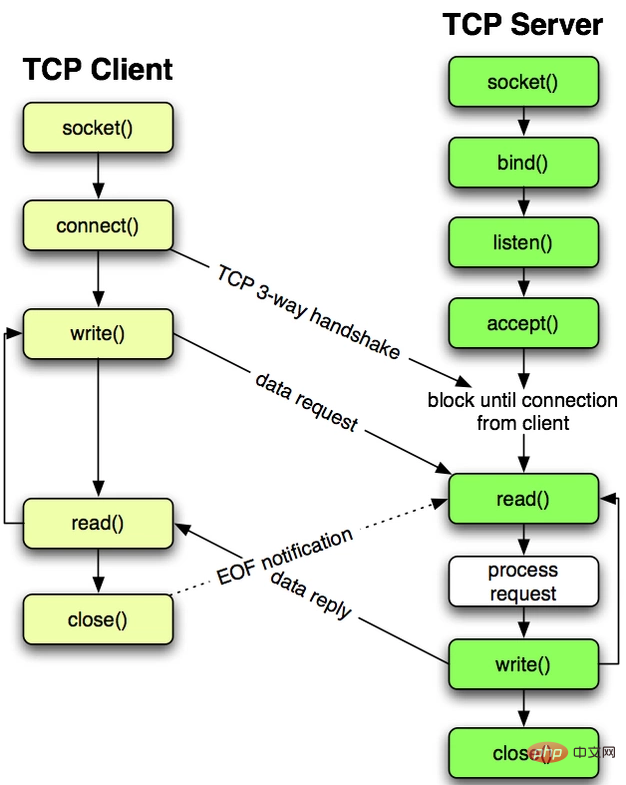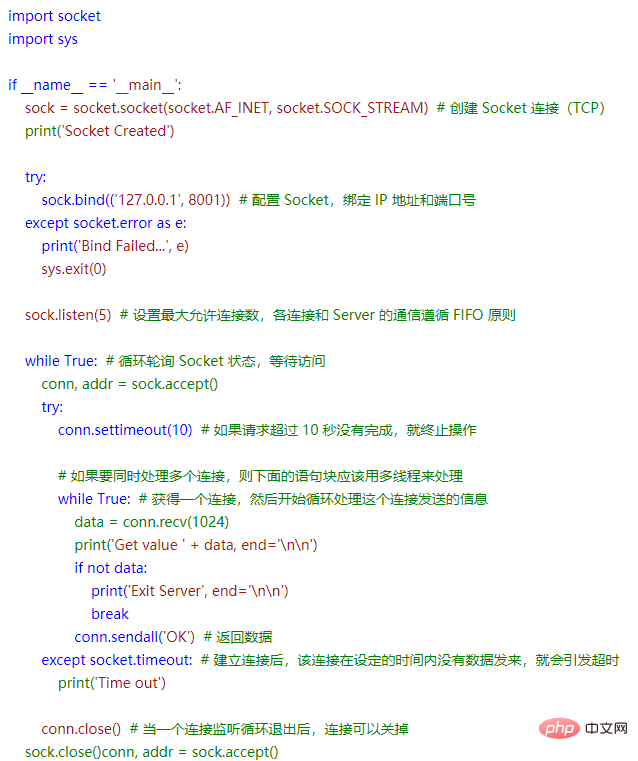How to understand php socket

What is a socket?
Socket is an abstraction layer between the application layer and the transport layer. It abstracts the complex operations of the TCP/IP layer into several simple interfaces for the application layer to call the implementation process in the network. Communication. Socket originated from UNIX. Under the UNIX idea that everything is a file, inter-process communication is named file descriptor. Socket is an implementation of the "open-read/write-close" mode. Server and client Each client maintains a "file". After the connection is established and opened, content can be written to the file for the other party to read or the other party's content can be read. The file is closed when the communication ends.
The picture shows the location of Socket:

Socket communication process
Socket ensures that communication between different computers communication, that is, network communication. For websites, the communication model is communication between the server and the client. A Socket object is established at both ends, and then data is transmitted through the Socket object. Usually the server is in an infinite loop, waiting for the client to connect.
Related learning video tutorial sharing: php video tutorial
The following picture is a connection-oriented TCP timing diagram:

Client process:
The client process is relatively simple, create a Socket, connect to the server, and connect the Socket to the remote host (note: only TCP has the concept of "connection", some Sockets such as UDP, ICMP and ARP do not have the concept of "connection"), send data, read response data, until the data exchange is completed, close the connection, and end the TCP conversation.

The send() method is also available here: the difference is that sendall() will try to send all data before returning, and returns None when successful, while send() returns to send The number of bytes, an exception will be thrown on failure.
Server-side process:
Let’s talk about the server-side process. The server first initializes the Socket, establishes a streaming socket, and communicates with the local machine address and port. Bind, then notify TCP that it is ready to receive connections, call accept() to block, and wait for a connection from the client. If the client establishes a connection with the server at this time, the client sends a data request, the server receives the request and processes the request, and then sends the response data to the client, and the client reads the data until the data exchange is completed. Finally, the connection is closed and the interaction ends.

When accept() is called, the Socket will enter the waiting state. When the client requests a connection, the method establishes the connection and returns to the server. accept() returns a tuple with two elements (conn, addr). The first element conn is the new Socket object through which the server must communicate with the client; the second element addr is the client's IP address and port. data = conn.recv(1024)
The next step is the processing phase, where the server and client communicate (transmit data) through send() and recv().
The server calls send() and sends information to the client in the form of a string. send() returns the number of characters sent.
The server calls recv() to receive information from the client. When calling recv() , the server must specify an integer that corresponds to the maximum amount of data that can be received with this method call. recv() will enter the blocked state when receiving data, and finally return a string to represent the received data. If the amount of data sent exceeds what recv() allows, the data will be truncated. The excess data will be buffered on the receiving end. When recv() is called in the future, the remaining bytes will continue to be read. If there is excess data, it will be deleted from the buffer (as well as the client may have sent since the last call to recv() any other data). When the transmission is completed, the server calls Socket's close() to close the connection.
Look at the Socket process from the perspective of TCP connection:
TCP three-way handshake Socket process:

1. After the server calls socket(), bind(), and listen() to complete the initialization, it calls accept() to block and wait;
2. The client Socket object calls connect() and sends a message to the server. SYN and blocking;
3. The server completes the first handshake, that is, sends SYN and ACK responses;
4. After the client receives the response sent by the server, connect() Return and then send an ACK to the server;
5. The server Socket object receives the client's third handshake ACK confirmation. At this time, the server returns from accept() to establish a connection.
The next step is for the connection objects at both ends to send and receive data to each other.
TCP Socket process of four waves:

1. An application process calls close() to actively close and send a FIN;
2. After receiving the FIN, the other end passively executes the shutdown and sends an ACK confirmation;
3. Afterwards, the application process that passively executes the shutdown calls close() to close the Socket and also sends a FIN;
4. The end that receives this FIN acknowledges it with ACK from the other end.
Summary:
The above code simply demonstrates the use of basic functions of Socket. In fact, no matter how complex the network program is, these basic functions will be used. The above server code will only process one client request before processing the next client request. Such a server has very weak processing capabilities. In practice, servers need to have concurrent processing capabilities. In order to achieve concurrent processing, the server needs to fork. A new process or thread handles the request.
Recommended related articles and tutorials: php tutorial
The above is the detailed content of How to understand php socket. For more information, please follow other related articles on the PHP Chinese website!

Hot AI Tools

Undresser.AI Undress
AI-powered app for creating realistic nude photos

AI Clothes Remover
Online AI tool for removing clothes from photos.

Undress AI Tool
Undress images for free

Clothoff.io
AI clothes remover

Video Face Swap
Swap faces in any video effortlessly with our completely free AI face swap tool!

Hot Article

Hot Tools

Notepad++7.3.1
Easy-to-use and free code editor

SublimeText3 Chinese version
Chinese version, very easy to use

Zend Studio 13.0.1
Powerful PHP integrated development environment

Dreamweaver CS6
Visual web development tools

SublimeText3 Mac version
God-level code editing software (SublimeText3)

Hot Topics
 PHP 8.4 Installation and Upgrade guide for Ubuntu and Debian
Dec 24, 2024 pm 04:42 PM
PHP 8.4 Installation and Upgrade guide for Ubuntu and Debian
Dec 24, 2024 pm 04:42 PM
PHP 8.4 brings several new features, security improvements, and performance improvements with healthy amounts of feature deprecations and removals. This guide explains how to install PHP 8.4 or upgrade to PHP 8.4 on Ubuntu, Debian, or their derivati
 7 PHP Functions I Regret I Didn't Know Before
Nov 13, 2024 am 09:42 AM
7 PHP Functions I Regret I Didn't Know Before
Nov 13, 2024 am 09:42 AM
If you are an experienced PHP developer, you might have the feeling that you’ve been there and done that already.You have developed a significant number of applications, debugged millions of lines of code, and tweaked a bunch of scripts to achieve op
 How To Set Up Visual Studio Code (VS Code) for PHP Development
Dec 20, 2024 am 11:31 AM
How To Set Up Visual Studio Code (VS Code) for PHP Development
Dec 20, 2024 am 11:31 AM
Visual Studio Code, also known as VS Code, is a free source code editor — or integrated development environment (IDE) — available for all major operating systems. With a large collection of extensions for many programming languages, VS Code can be c
 Explain JSON Web Tokens (JWT) and their use case in PHP APIs.
Apr 05, 2025 am 12:04 AM
Explain JSON Web Tokens (JWT) and their use case in PHP APIs.
Apr 05, 2025 am 12:04 AM
JWT is an open standard based on JSON, used to securely transmit information between parties, mainly for identity authentication and information exchange. 1. JWT consists of three parts: Header, Payload and Signature. 2. The working principle of JWT includes three steps: generating JWT, verifying JWT and parsing Payload. 3. When using JWT for authentication in PHP, JWT can be generated and verified, and user role and permission information can be included in advanced usage. 4. Common errors include signature verification failure, token expiration, and payload oversized. Debugging skills include using debugging tools and logging. 5. Performance optimization and best practices include using appropriate signature algorithms, setting validity periods reasonably,
 PHP Program to Count Vowels in a String
Feb 07, 2025 pm 12:12 PM
PHP Program to Count Vowels in a String
Feb 07, 2025 pm 12:12 PM
A string is a sequence of characters, including letters, numbers, and symbols. This tutorial will learn how to calculate the number of vowels in a given string in PHP using different methods. The vowels in English are a, e, i, o, u, and they can be uppercase or lowercase. What is a vowel? Vowels are alphabetic characters that represent a specific pronunciation. There are five vowels in English, including uppercase and lowercase: a, e, i, o, u Example 1 Input: String = "Tutorialspoint" Output: 6 explain The vowels in the string "Tutorialspoint" are u, o, i, a, o, i. There are 6 yuan in total
 How do you parse and process HTML/XML in PHP?
Feb 07, 2025 am 11:57 AM
How do you parse and process HTML/XML in PHP?
Feb 07, 2025 am 11:57 AM
This tutorial demonstrates how to efficiently process XML documents using PHP. XML (eXtensible Markup Language) is a versatile text-based markup language designed for both human readability and machine parsing. It's commonly used for data storage an
 Explain late static binding in PHP (static::).
Apr 03, 2025 am 12:04 AM
Explain late static binding in PHP (static::).
Apr 03, 2025 am 12:04 AM
Static binding (static::) implements late static binding (LSB) in PHP, allowing calling classes to be referenced in static contexts rather than defining classes. 1) The parsing process is performed at runtime, 2) Look up the call class in the inheritance relationship, 3) It may bring performance overhead.
 What are PHP magic methods (__construct, __destruct, __call, __get, __set, etc.) and provide use cases?
Apr 03, 2025 am 12:03 AM
What are PHP magic methods (__construct, __destruct, __call, __get, __set, etc.) and provide use cases?
Apr 03, 2025 am 12:03 AM
What are the magic methods of PHP? PHP's magic methods include: 1.\_\_construct, used to initialize objects; 2.\_\_destruct, used to clean up resources; 3.\_\_call, handle non-existent method calls; 4.\_\_get, implement dynamic attribute access; 5.\_\_set, implement dynamic attribute settings. These methods are automatically called in certain situations, improving code flexibility and efficiency.






